#The Buddhist Retreat Centre
Text
CHILLY WET WEATHER FAVOURITE
So what’s on the stove today?
No prize for the answer.
Soup, of course.
My automatic response to drizzle, cloudy skies and low, low temps. Interestingly, Afrikaans cooks don’t reach for their soup pots, they automatically get into Pancake cooking mode. They even have words to cover this weather/traditional event : pannekoek weer. Literally translated as pancake weather. They produce tons of…
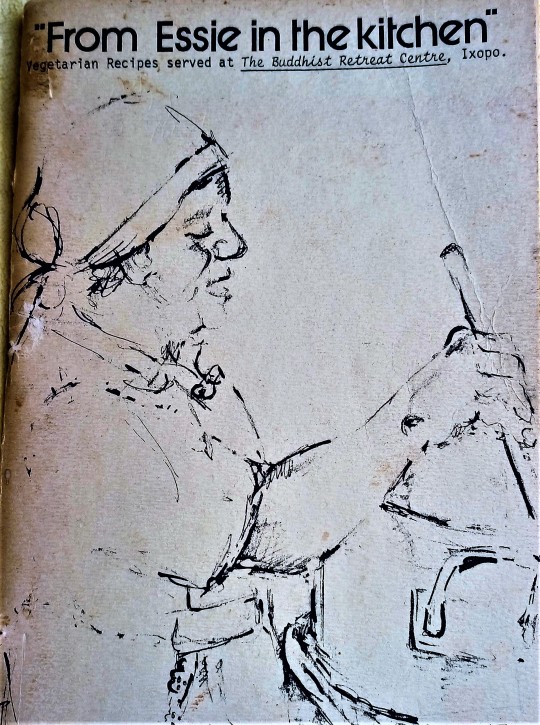
View On WordPress
0 notes
Text

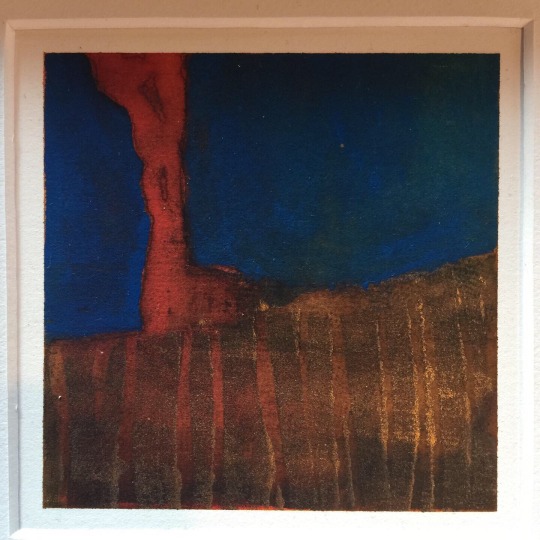

Three of the four pieces I have donated to a fundraising exhibition for Tiratanaloka Unlimited, a bigger retreat centre for women training for ordination into the Buddhist order to which I belong. The fourth item is a cushion.
Various yarns, mixed media
18 notes
·
View notes
Text
Hakuin returned home, took up residence in the temple, and attended his ailing father. Even though the temple was in a terrible condition and sited in the centre of a bustling village, Hakuin carried on a version of the retreat schedule he had followed when he was up on the mountain. He describes in his autobiography how every night he would adopt the zazen position, then instruct one of the temple boys to wrap a futon around him and tie it on with a rope to keep him in an upright position. He would sit tied up in meditation right through to morning.
It seems that it was during this time that Hakuin worked out a way to combine the teachings of Hakuyushi with his Zen koan study. Gradually word got out about the earnest and deeply realised monk in the tiny temple, and students started to appear – not only the local villagers who began to enquire about Zen, but also male and female monastics from further afield. Hakuin began to teach, somewhat reluctantly, as he felt his own practice wasn’t yet complete.
And then one night, in 1726, when he was 41 years old and had been resident at Shoinji for a decade, he sat studying the Lotus Sutra, perhaps the most venerated Buddhist text in Japan. A cricket started to shrill in the foundations of the temple and, as he heard this noise, the whole universe opened up for him. He let out an involuntary shout and began to weep. From this time on Hakuin lived in a state of complete liberation, and for the next 40 years he devoted himself to his students. This teaching effort included sanzen (one-to-one interviews), as well as lecturing to increasingly large groups. He also wrote many books on Zen.
Before long the tiny temple was filled with Zen students. Hakuin didn’t move to larger premises; instead, he began to gather the overflowing monks into groups of three, and sent them off into the surrounding countryside. These monks would live in old shrines, fishermen’s huts, under trees – anywhere they could find shelter. Eventually it reached a point where the whole landscape was a kind of monastery without walls.
We have an account from a famous poet, Takatsuki Rikei, who came to visit Hakuin in 1753. Rikei describes how there were about 150 monastic students, of whom ten lived in the temple. The other 140 would come in at different times during the day for their sanzen and then return to their dwellings. This grassroots, spontaneous dharma centre was unique. Nothing quite like it has happened since.
-- Skinner Julian Daizan, Practical Zen
1 note
·
View note
Text
Dew Drop Homestay | Best Homestay in Kalimpong
Welcome to Dew Drop Homestay in Kalimpong!
Nestled atop the lush green hills of Kalimpong, Dew Drop Homestay offers an enchanting escape from the hustle and bustle of everyday life. Our homestay is a harmonious blend of comfort, natural beauty, and warm hospitality. As you step into our tranquil haven, you'll be greeted by breathtaking vistas of the majestic Kangchenjunga and the graceful Teesta River meandering through the valley below.
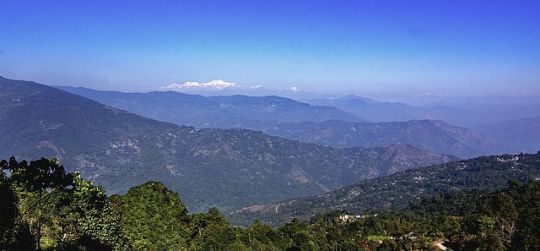
The Setting: A Slice of Paradise
Imagine waking up to the soft rays of the sun kissing the snow-capped peaks of Kanchendzongha. Each room at Dew Drop Homestay is thoughtfully designed to maximize these awe-inspiring views. Whether you choose a cozy suite or a spacious deluxe room, you'll be treated to a front-row seat to nature's grandeur. Step out onto your private balcony, take a deep breath of fresh mountain air, and let the tranquility wash over you.
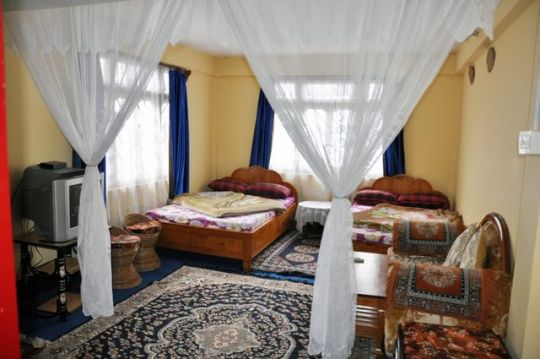
Rooms and Amenities
Our rooms are elegantly furnished, combining modern comforts with traditional aesthetics. Wooden floors, plush beds, and large windows create a soothing ambiance. Picture yourself sipping a cup of Darjeeling tea while watching the mist rise from the valley—a moment frozen in time.
Deluxe Rooms: Wake up to panoramic views of the Himalayas. These rooms are perfect for couples seeking a romantic getaway or families looking for a serene retreat.
Dining with a View
Our in-house restaurant, *Cloudscape*, offers a delightful culinary journey. Savor local delicacies and Bengali cuisines. The best part? Every meal comes with a side of breathtaking scenery. Whether you're enjoying breakfast or a candlelit dinner, the Kanchendzongha and Teesta River will be your dining companions.
Exploring Kalimpong: Kalimpong, a hidden gem in West Bengal, offers a plethora of activities that cater to every kind of traveler. Here's a guide to some of the most exciting experiences around Kalimpong. Dew Drop Homestay is ideally located for exploring the wonders of Kalimpong:
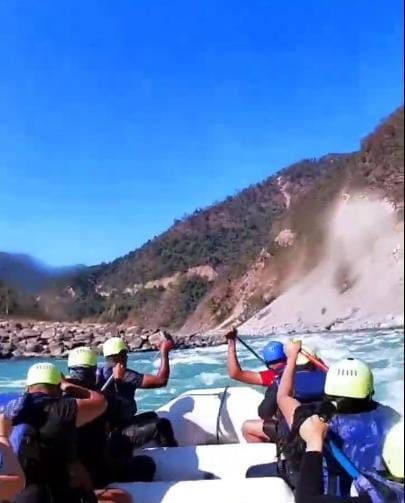
- Paragliding at Delo Hills: Soar through the skies and enjoy a bird's-eye view of Kalimpong's stunning landscape with paragliding at Deolo Hills. Feel the adrenaline rush as you glide over verdant valleys, rivers, and tea gardens.
- Teesta River Rafting: For adventure enthusiasts, a thrilling rafting experience awaits on the Teesta River.
- Pine View Cactus Garden: Home to the largest collection of cacti in Asia, the Pine View Cactus Garden is a unique attraction. With over 1,000 species, this garden is a testament to the diversity of nature's creations³.
- Durpin Dara Monastery: Also known as Zang Dhok Palri Phodang, this monastery is a peaceful retreat. It houses sacred Buddhist scriptures and offers stunning views of the Himalayas.
- Mangal Dham: A temple dedicated to Lord Krishna, it's an architectural marvel and a place of serenity.
- Thongsa Gompa: The oldest Bhutanese monastery in Kalimpong, offering a glimpse into the region's rich cultural heritage.
- Zang Dhok Palri Phodang: Visit this serene Buddhist monastery, perched on a hilltop. The colorful prayer flags fluttering in the breeze add to the spiritual ambiance.
- Science Park at Deolo Hill: Kalimpong Science Centre is situated near to Deolo Hill. It houses science observatory, 3D movie theater and some scientific objects for display including live working models. The place also has a nice garden with certain outdoor activities mostly for kids like swings, climbing ropes, see-saws, models of dinosaurs etc.
- Kalimpong Arts & Craft Centre: Explore local handicrafts and support the artisans of Kalimpong.
- Events and Celebrations
Planning a special occasion? Our open-air terrace is perfect for weddings, anniversaries, and corporate retreats. Imagine exchanging vows against the backdrop of the Himalayas—the stuff dreams are made of.
- Book Your Stay
At Serene Heights Retreat, we believe that every guest deserves a slice of paradise. Book your stay now and immerse yourself in the magic of Kalimpong. Whether you're a nature lover, a seeker of tranquility, or an adventurer, our doors are open to you.
Whether you're seeking adventure, peace, or cultural enrichment, Kalimpong's diverse offerings ensure an unforgettable visit. Embrace the beauty and spirit of this quaint hill station as you explore its many treasures.
0 notes
Text
youtube
Shingon Esoteric Buddhism explained #ShingonBuddhism #EsotericBuddhism #buddhistphilosophy
What defines Shingon Esoteric Buddhism? How do its teachings diverge from exoteric Buddhist practices? What are the experiences of spiritual retreats like Mount Koya? And what is the significance of initiation rites such as kanjō?
This video investigates the tradition's key practices and philosophical tenets, providing a scholarly overview of this profound path to enlightenment.
Discover the teachings of Kukai, the ritualistic intricacies of Ajikan meditation and the Goma fire ritual, and the doctrine of sokushin jobutsu, which advocates for attaining Buddhahood within one's own life. A concise guide to the Mahavairocana Sutra is offered, explaining its role in Shingon's meditative and ritual framework, alongside an explanation of the sacred mantras and mudras.
CONNECT & SUPPORT💖
WEBSITE & NEWSLETTER 💌 https://ift.tt/O1SIuiP
BOOK A TUTORING OR A LECTURE 📖https://ift.tt/vS6Omg5
BECOME MY PATRON! 🎩 https://ift.tt/DqZk56F
SUPPORT ME ON KO-FI ☕️https://ift.tt/hpxz6mW
ONE-OFF DONATIONS 💰 https://ift.tt/AKIfqzB
JOIN MEMBERSHIPS 👥 https://www.youtube.com/channel/UCPSbip_LX2AxbGeAQfLp-Ig/join
MY PODCAST 🎙 https://ift.tt/w0xMBOA
MY MERCH 👕 https://ift.tt/hel9cDM
FOLLOW ME👣
- YouTube (@drangelapuca)🌟
- Instagram (@drangelapuca) 📸
- TikTok (@drangelapuca) 🎵
- Twitter (@angelapuca11) 🐦
- Facebook (Dr Angela Puca) 👥
REFERENCES 📚
Hakeda, Y. S. (1972). Kukai: Major Works. Columbia University Press.
Orzech, C., Sørensen, H., & Payne, R. K. (Eds.). (2011). Esoteric Buddhism and the Tantras in East Asia. Brill.
Payne, R. K. (Ed.). (2006). Tantric Buddhism in East Asia. Wisdom Publications.
Snodgrass, A. (1988). The Matrix and Diamond World Mandalas in Shingon Buddhism. Aditya Prakashan.
Yamasaki, T. (1988). Shingon: Japanese Esoteric Buddhism. Shambhala.
MY SET-UP 🛠️
- Canon 90D camera 📸 https://amzn.to/3yQclh0
- Canon EF-S 18-55mm f/3.5-5.6 📷 https://amzn.to/3JjU1BS
- Teleprompter 🗒️ https://amzn.to/3linWCB
- Shure SM7B Microphone 🎙️ https://amzn.to/3Jm5IYK
- Microphone stand 🎤 https://amzn.to/3FueJOn
- Lights 💡 https://amzn.to/3Zdk8k1
- DJI Wireless microphones 📡 https://amzn.to/3NWAVVQ
00:00 Introduction Dr Puca's Pilgrimage to Japan
00:51 What is Shingon Esoteric Buddhism?
01:26 The Start of Shingon Buddhism
03:02 Support Angela's Symposium
04:09 Art, Culture, and the Pursuit of Enlightenment
06:56 Mount Koya – the centre of Shingon Buddhism
07:58 The Theoretical Foundations of Shingon Buddhism
08:32 The Distinction between esoteric and exoteric Buddhist Practice
09:05 Shingon's Concept of Two Truths
09:50 Mahavairocana Sutras, Mudras and Mantras
11:33 Buddhist Practices in Shingon
14:03 Shingon Initiation and Empowerment (Abhiseka)
15:42 The differences between esoteric and exoteric Buddhism
18:05 The Role of the Guru/Master in Shingon Buddhism
18:47 The Goal of Shingon Buddhism
19:27 Summary: Shingon Buddhism
21:49 Support Angela's Symposium
⚠️ Copyright of Dr Angela Puca, in all of its parts ⚠️
Music by Erose MusicBand. Check them out!
via YouTube https://www.youtube.com/watch?v=Sw3Ru7T7aPk
0 notes
Text
Start Your Enlightenment Journey with The Taj In India Company's Spiritual Tours of India

Throughout history, people from all over the world have looked to India, a country rich in spirituality and mysticism, for guidance and calm. India is a special place for people who want to go on a spiritual trip because of its wide variety of religious traditions, holy places, and mystical customs. Explore India's spiritual core with the carefully crafted Spiritual Tours offered by The Taj In India Company, a leading travel service that specializes in custom trips throughout the subcontinent.
Explore India's Soul
The Taj In India Company offers immersive experiences that provide insights into the rich spiritual legacy of this ancient region, extending beyond visits to holy locations on spiritual tours throughout India. A deeper understanding of India's many spiritual traditions, such as Buddhism, Hinduism, Sikhism, Jainism, and Sufism, is intended to be imparted on each carefully planned journey.
The Everlasting City of Varanasi
One of the world's oldest cities and a major destination for Hindu pilgrims, Varanasi, is a must-see for anyone doing a spiritual trip of India. With the ardor of devotion, the Ganges riverbank stairs, or ghats, come to life as The Taj In India Company leads you through this ethereal city. Take in a boat trip at dawn to see life and spirituality blending alongside the holy river, and witness the Ganga Aarti, a captivating riverbank ceremony.
The Two Pilgrimages of Rishikesh and Haridwar
Known for its spiritual significance and breathtaking natural beauty, Rishikesh and Haridwar are situated in the Himalayan foothills. As the "Yoga Capital of the World," Rishikesh is known for its rich yogic culture, which The Taj In India Company offers an immersive experience of. Take part in the incredibly moving Ganga Aarti ceremony at Har Ki Pauri in Haridwar; its spiritual intensity will enchant you.
Tibet's Journey through Dharamshala and McLeod Ganj
See the tranquil settings of McLeod Ganj, the exile residence of His Holiness the Dalai Lama, and Dharamshala. These peaceful havens for those looking for spiritual development and serenity are home to several Tibetan Buddhist centers. Reaching out to the Tibetan community, touring monasteries, and maybe even attending lessons or meditation sessions are all made possible by The Taj In India Company, which provides an insight into the compassionate teachings of Buddhism.
The Jewel of Sikhism, Amritsar
Sikh culture and spirituality are centred in Amritsar, the city that houses the Golden Temple. Traveling to this majestic temple, where the values of equality, service, and dedication are realized, is an unforgettable experience provided by The Taj In India Company. Indulge in the Langar, a communal kitchen that provides thousands of people free meals every day, emulating the Sikh principles of altruism and harmony among the community.
Individualized Spiritual Journeys
Since spirituality is a very personal journey, The Taj In India Company takes great pleasure in designing custom itineraries that meet each traveler's unique needs and spiritual goals. The Taj In India Company guarantees a voyage that suits your spiritual search, whether you're drawn to a specific tradition's teachings, looking for a meditation retreat, or wanting to visit the holy sites of several different religions.
Why Make Your Spiritual Journey with The Taj In India Company Your First Choice?
You are choosing an experience that goes beyond the ordinary when you choose The Taj In India Company for your spiritual travels in India. The Taj In India Company is the best resource for learning about India's spiritual landscape because of their experience, availability of informed guides, and dedication to offering genuine and respectful interactions with the country's spiritual traditions.
For ages, travelers have been led to India's coastlines by spiritual tours offered by The Taj In India Company. These tours are more than just trips between locations; they're expeditions into the depths of the soul, quests for wisdom, and tranquility. Experience India's spiritual wealth by traveling with The Taj In India Company and embarking on this auspicious adventure.
Delhi Temples and Spiritual Sites – 6 Hours
Skip The Line
Duration : 1 Days
Free cancellation
Instant confirmation
Private Tour
Overview - Delhi Temples and Spiritual Sites Tour
Because of its occupied and uproarious modern and business segments, Delhi has a standing as a swarmed, swarmed city. Being the most populated city in India, its metropolitan regions experience a continuous progression of individuals and vehicles. Be that as it may, you’ll be stunned to see the harmony and quiet past a few of Delhi’s heavenly spots. There are a few Hindu and Jain sanctuaries as well as Sufi Sanctums, Old Mosques, Gurudwaras, and different spots of love around Delhi. You will have the potential chance to investigate some of them on this Spiritual Delhi Tour.
Tour Highlights
Delhi’s elite 6-hour Profound Visit.
Get stunned by Akshardham Sanctuary’s size.
Notice Lotus Sanctuary’s botanical propelled development.
Witness Jama Masjid’s eminence.
Find the Gurudwara and the Sikh religion.
Service for Live Tour Guides.
Help with get and drop-off.
Tour Itinerary
09:00 A.M - Pick Up from hotel in Delhi/NCR.
Inclusion / Exclusion
Pick and Drop off Assistance.
Round trip Air Conditioned Car Service.
Entrance Tickets of all Monuments.
Buffet Lunch at Luxury Restaurant.
Live Tour Guide Service.
Applicable taxes
Complimentary water bottles {in Car}
Parking, Tolls, fuel & Road Tax included
All taxes.
0 notes
Text

What Is a Tulku?
Tulku (Tibetan: gary) an incarnation or emanation. The word literally means nirmanakaya, but is used in common speech to refer to any incarnate lama. The tradition of recognizing reincarnate masters began in Tibet in the early 12th century with the line of Karmapas.
Penor Rinpoche writes:
Traditionally a tulku is considered to be a reincarnation of a Buddhist master who, out of his or her compassion for the suffering of sentient beings, has vowed to take rebirth to help all beings attain enlightenment. To fulfill this aspiration, a tulku will generally need to go through the complete process of recognition, enthronement and training.
Formal recognition generally occurs soon after a tulku has been identified, but only after other important lineage masters have been consulted. The newly identified tulku does not take on any formal responsibilities at the time of recognition.
The next step of enthronement may or may not occur for a tulku, depending on the circumstances. Enthronement formally invests the tulku with the responsibility of furthering the activities associated with their particular tulku lineage. Thus, if there are specific teachings and practice traditions associated with their lineage, and if there are perhaps monks, nuns, monasteries, retreat centres, lay communities and so forth for which the tulku traditionally takes responsibility, then the tulku is formally vested with those responsibilities at the time of enthronement. In the event that an enthronement ceremony is conducted, it may take place soon after recognition or some years later. If the tulku is too young to assume their responsibilities upon enthronement, others may be entrusted to take on those responsibilities until the tulku is ready.
Finally, a tulku needs to complete a formal course of training which includes years of study and meditation. This training reawakens the tulku's powers of insight and compassion and develops their skillful means for helping others. It is only after such training that a tulku is ready to take on the role of a teacher.
HH XVI Karmapa Rangjung Rigpe Dorje is pictured below at Rumtek Monastery, Sikkim
#karmapa#buddha#buddhist#buddhism#dharma#sangha#mahayana#zen#milarepa#tibetan buddhism#thich nhat hanh
1 note
·
View note
Text
Tadiandamol Trekking Gear Guide: Essentials for a Successful Hike

Tadiandamol Trek: Conquer the Highest Peak of Coorg
Tadiandamol Trek Coorg in Karnataka, India, offers an exhilarating adventure to the highest peak at 1,748 metres. The trek winds through lush forests and meadows, showcasing diverse flora and fauna. Starting in Kakkabe village, it combines moderate challenges with stunning vistas, making it a must-do for nature lovers and trekkers seeking a memorable escape into the Western Ghats.
Best Time to Embark on Tadiandamol Trek: Seasons for Adventure
The best time for Tadiandamol trekking and outdoor activities is during the post-monsoon and winter months, typically from September to February. Here's a breakdown of the seasons:
Post-Monsoon (September to November): This period offers lush green landscapes and pleasant weather immediately after the monsoon season. The rains have refreshed the surroundings, and the temperatures are relatively calm, making it an ideal time for trekking.
Winter (December to February): Tadiandamol weather during winter is cooler, making it comfortable for trekking during the day. However, nights can be pretty cold, so wear warm clothing. The clear skies and crisp air during this time offer excellent visibility and stunning views from the summit.
Avoid visiting Tadiandamol during the monsoon season (June to August), as heavy rains can make the trails slippery and dangerous. Also, the summer months (March to May) can be hot and less conducive for trekking due to the high temperatures.Remember that weather conditions vary yearly, so checking local forecasts before planning your trip is a good idea. Visit Universal Adventures for guided trekking itinerary and packages.
Itinerary For the Tadiandamol Trek Coorg
Day 1: A Nighttime Journey from Bangalore
The Tadiandamol trekking adventure kicks off with an overnight bus journey from Bangalore to the trek's base. Ensure you've had your meals or packed some for the trip before you board the bus.
Prepare your luggage and arrive at the designated pickup point at the scheduled time. You have several pickup points in Bangalore to choose from, so select one that suits you best. Climb aboard the bus or Tempo Traveller and commence an exciting trekking expedition.
During this journey, take the opportunity to acquaint yourself with our team and fellow trekkers who will be your companions throughout this adventure. As the bus transports you from the bustling world of Bangalore to the tranquil heights of Tadiandamol Coorg, don't forget to gaze up at the night sky and appreciate the transition.
Day 2: Ascending to Tadiandamol's Summit: Trekking Through Trek Day
Following an overnight bus journey, you'll arrive at the base camp around 5:30 AM. After a quick breakfast, gear up for the thrilling trek to Tadiandamol Peak, the highest point in Kodagu at 1748 metres. The tour offers stunning natural vistas, and we'll pause for lunch at the summit while you capture the breathtaking scenery.
Upon descending, enjoy tea or coffee with snacks, and as night falls, gather around a bonfire to share stories. Dinner will be served; you can savour the flavours while gazing at the starry sky. Finally, retreat to your accommodations for a peaceful night's sleep.
Day 3: Exploring Beauty and Farewell to Bangalore
On the last day of the Tadiandamol trek, we start with an 8 AM breakfast. We then depart for Bangalore, with two exciting stops along the way.
First, we visit the Dubare Elephant Camp, where you can feed, bathe, and even ride elephants while enjoying the natural beauty and birdwatching.
Next, we explore the Namdroling Monastery, one of the world's largest Buddhist centres, witnessing monks' rituals and wandering through its tranquil halls.
Lunch is at a nearby restaurant with scenic views. Finally, we return to Bangalore, concluding our trek with a bus ride home, filled with wonderful memories.
Also checkout another amazing trekking spot Kudremukh Trek

Tadiandamol Trek: Essential Gear Guide
When embarking on the Tadiandamol trek, having the right gear to ensure a safe and comfortable journey is crucial. Here's a list of essential items you should consider bringing to your trek:
Trekking Shoes: Sturdy and comfortable shoes with good grip are essential for tackling varying terrains.
Backpack: A durable and spacious backpack to carry your essentials and keep your hands free during the trek.
Clothing: The weather can be unpredictable so dress in layers to adapt to changing weather conditions. Include moisture-wicking and quick-drying clothing. Remember a light rain jacket or poncho in case of rain.
Headlamp/Flashlight: A reliable light source for early morning starts or late-night activities.
Trekking Poles: Optional but valuable for stability and balance, especially on steep descents.
Water and Hydration: Carry a reusable water bottle or hydration bladder throughout the trek. Water sources are often along the trail, but purification tablets or a filter can be handy.
Snacks: Pack energy-boosting snacks like nuts, energy bars, and chocolates.
First Aid Kit: A basic kit with essentials like band-aids, antiseptic wipes, pain relievers, and personal medications.
Navigation: A map, compass, or GPS device to help you stay on the right path.
Sun Protection: Remember to bring Sunscreen, sunglasses, and a hat for protection against the sun's rays.
Insect Repellent: This is especially important if you're trekking during the monsoon season.
Trekking Gear: Depending on your preferences, you should bring trekking pants, moisture-wicking socks, and moisture-wicking base layers. Remember gloves and a warm hat if you're trekking in colder months.
Camera: If you're into photography, remember your camera or smartphone for capturing stunning views.
ID and Documents: Carry a copy of your identification, permits, and emergency contact information.
Trash Bags: To carry out all your trash and leave no trace.
Remember to check the specific requirements and recommendations of your trekking tour operator or local authorities, as they may vary based on the season and weather conditions. Always be prepared and prioritise safety and comfort during your Tadiandamol trek.
Suggested read - Safety Measures on Tadiandamol Trek: Ensuring a Secure Hike
Discovering Coorg's Hidden Treasures: Trekking Places in Coorg
Coorg, also known as Kodagu, is a beautiful hill station in Karnataka, India, and it offers several trekking destinations apart from Tadiandamol. Here are some other trekking places in Coorg:
Brahmagiri Trek: This trek takes you to the Brahmagiri Peak, offering stunning views of the Western Ghats. It's known for its lush forests, diverse flora, and the Irupu Falls along the way.
Kotebetta Trek: Kotebetta is the third-highest peak for Coorg trekking and is famous for its panoramic views. The trek takes you through coffee plantations and dense forests.
Pushpagiri Trek: Pushpagiri, the second-highest peak in Karnataka, is a challenging trek. It's known for its biodiversity, and you may spot various species of birds and wildlife.
Kumara Parvatha Trek: This is one of the most challenging and adventurous treks in Coorg, taking you to Kumara Parvatha, the highest peak in the Pushpagiri Wildlife Sanctuary. It's known for its dense forests and meadows.
Chelavara Falls Trek: While a short trek, it's a beautiful trail leading to Chelavara Falls, a picturesque waterfall surrounded by lush greenery.
Kakkabe Trek: Kakkabe is a base for several trekking trails, including Thadiyandamol.
Nishani Betta Trek: This trek offers panoramic views of Coorg's landscapes, especially during sunrise or sunset. It's considered to be a relatively easy trek that is suitable for beginners.
Remember to check the current trekking conditions, obtain any necessary permits, and consider the difficulty level before embarking on any trek in Coorg. Additionally, it's often a good idea to go with an experienced guide, especially if you're unfamiliar with the area.
Always remember, that success on a trek hinges on careful preparation.
Happy Trekking!
#tadiandamol trek coorg#coorg trekking#trekking places in coorg#tadiandamol weather#tadiandamol coorg
0 notes
Text
Sikkim's Spiritual Retreats for Solo Travelers
Nestled in the lap of the Himalayas, Sikkim is a hidden gem in India's northeastern region, known for its breathtaking landscapes, rich cultural heritage, and spiritual significance. It is a paradise for solo travelers seeking a unique blend of natural beauty and spiritual enrichment. In recent years, Sikkim has gained popularity as a destination for spiritual retreats, attracting solo travelers from all around the world. In this article, we will explore some of the spiritual retreats in Sikkim that offer solace, self-discovery, and a deeper connection with nature and the inner self. Want to explore the beauty and adventure of sikkim check our car rental service in gangtok
Rumtek Monastery: The Jewel of Sikkim
Rumtek Monastery, located near Gangtok, is one of the most significant and spiritually influential places in Sikkim. This Buddhist monastery, also known as the Dharma Chakra Centre, is a serene retreat for those seeking solace and spiritual enlightenment. Surrounded by lush greenery, the monastery's architecture and ambiance exude an aura of peace and tranquility.
Solo travelers can participate in meditation sessions and interact with monks to gain insights into Tibetan Buddhism. The monastery also offers retreat programs that focus on mindfulness, meditation, and yoga, allowing visitors to disconnect from the hustle and bustle of daily life and connect with their inner selves.
Tashiding Monastery: A Place of Blessings
Tashiding Monastery is perched on a hilltop in West Sikkim, offering panoramic views of the surrounding mountains and valleys. This ancient monastery is believed to be a place of blessings, and its serene location makes it a perfect spot for solo travelers seeking spiritual rejuvenation.
The monastery conducts prayer ceremonies and rituals, and visitors can partake in these spiritual activities to experience the deep-rooted traditions of Sikkim. Tashiding also hosts the Bumchu Festival, where a sacred pot of holy water is opened for devotees, symbolizing purification and renewal.
0 notes
Text
Exploring Vipassana Meditation and Finding the Perfect Vipassana Meditation Center Near You
Vipassana meditation, an ancient practice rooted in the teachings of Gautama Buddha, has gained remarkable recognition for its transformative power in the modern world. By cultivating mindfulness and insight, Vipassana offers a path to profound self-awareness and liberation from suffering. This article delves into the profound realm of Vipassana meditation, provides insights into its techniques, discusses the journey of choosing the right meditation center, and explores the numerous benefits it offers.
I. Introduction to Vipassana Meditation
Origin and Philosophy
Vipassana traces its origins to the Buddhist tradition, specifically to the Theravada school. It emphasizes the observation of bodily sensations, thoughts, and emotions as a means of understanding the impermanent nature of existence.
Core Principles
Central to Vipassana is the concept of impermanence (anicca), the unsatisfactory nature of phenomena (dukkha), and the absence of an enduring self (anatta). Practitioners explore these truths through direct experience rather than blind faith.
Benefits of Vipassana Meditation
Vipassana offers a multitude of benefits, from stress reduction and emotional regulation to enhanced self-awareness and clarity of mind. Through diligent practice, individuals can develop equanimity, leading to a more balanced and harmonious life.
II. Understanding Vipassana Technique
Mindfulness and Awareness
Vipassana meditation centre begins with the development of mindfulness, the ability to observe thoughts, emotions, and sensations without judgment. This heightened awareness is the foundation of insight.
Body Scanning
Practitioners progressively scan their bodies, observing sensations with precision. This process reveals the impermanent and ever-changing nature of bodily experiences.
Impermanence and Equanimity
Vipassana reveals the transient nature of all experiences, fostering equanimity—a state of non-reactive balance—regardless of whether the experience is pleasant, unpleasant, or neutral.
III. Deep Dive into Vipassana Meditation
Observing Sensations
The practice trains individuals to observe sensations objectively, recognizing that they arise and pass away. This insight dismantles the illusion of solidity in our experiences.
Unraveling Mental Patterns
Meditation centre near me allows practitioners to become intimately acquainted with their thought patterns, breaking free from automatic reactions and cultivating a more intentional way of being.
Cultivating Concentration
Through sustained observation of sensations, concentration deepens. This heightened focus enables practitioners to penetrate the layers of their consciousness.
Liberation from Suffering
By understanding the true nature of reality, practitioners achieve liberation from suffering (nibbana/nirvana), attaining a state of ultimate freedom and inner peace.
IV. Choosing the Right Meditation Center
Importance of a Suitable Environment
The meditation center's atmosphere greatly influences the practice. Serene surroundings facilitate concentration and introspection.
Researching Meditation Centers
Research various centers to find one that resonates with your goals. Investigate the lineage, teaching methods, and experiences of previous attendees.
Retreat Durations and Intensity Levels
Meditation centers offer retreats of varying lengths and intensities. Beginners may opt for shorter retreats, gradually progressing to more extended periods of practice.
Daily Schedule and Routine
Retreats follow a strict routine, beginning early and encompassing several hours of meditation interspersed with mindful walking, meals, and rest.
Noble Silence and Detachment
Noble silence, refraining from verbal and non-verbal communication, allows practitioners to turn inward. Detachment from distractions enhances the depth of practice.
Guidance from Experienced Teachers
Teachers offer guidance, clarifying nuances of the practice and providing personalized suggestions to navigate challenges.
VI. Benefits of Practicing Vipassana Meditation
Stress Reduction and Emotional Regulation
Vipassana equips individuals with tools to manage stress and regulate emotions effectively, promoting mental well-being.
Enhanced Self-Awareness
Practitioners develop a profound understanding of their thought patterns, behaviors, and emotions, leading to heightened self-awareness.
Improved Concentration and Clarity
Regular practice sharpens concentration, enhancing cognitive clarity and fostering better decision-making skills.
0 notes
Text
Immerse yourself in wisdom with 'The Mind’s Cutting Edge: 12 Manjushris Meditation Retreat'. Explore the Vajrayana Buddhist archetype of wisdom - Manjushri. This retreat is a journey to enhance cognitive intelligence, discrimination, clarity, and thinking rigor. Embrace the teachings that delve into wisdom's various facets. Reconnect with your inner clarity and elevate your intellectual strength. Experience a transformative retreat that brings depth and insight to your understanding. Whether a seasoned practitioner or new to meditation, this retreat offers a profound exploration of wisdom in all its dimensions. Don't miss this opportunity to develop your cognitive abilities and tap into the essence of wisdom. Enroll now and embark on a journey of intellectual growth and mindfulness with 'The Mind’s Cutting Edge' Manjushri Meditation Retreat.
0 notes
Text
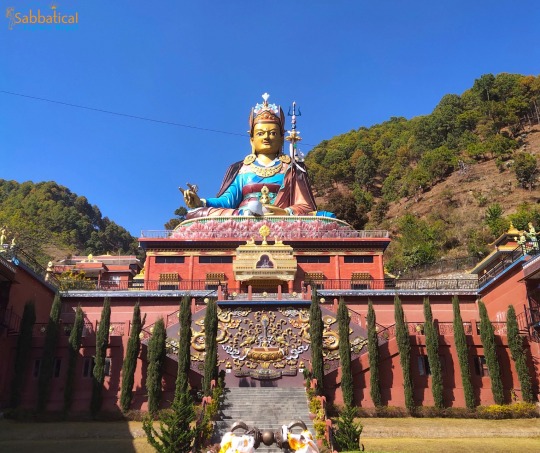

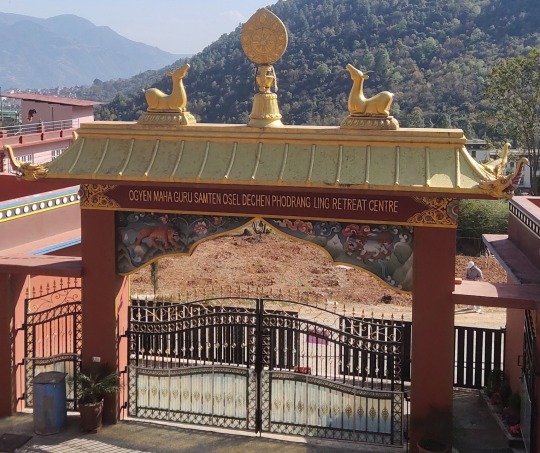
"Guru Rinpoche's giant statue at Ogyen Maha Guru Retreat Centre in Pharphing".
The sculpture is neighboured by several important Buddhist Spiritual sites and meditation retreat centers. Neydo Tashi Choling Monastery, Tegchen Leksheyling Retreat Centre, Palyal Samten Osel Ling. Yanglesho Cave and Asurva Cave are nearby the place.
Pharping, about 23 km from Kathmandu, is a great escape to immerse in nature, culture, peace, and spirituality.
#nepal#spiritualtours#meditation#retreatcentre#spirituality#gururinpoche#pharping#lifetimeexperiences#traveling#travelideas#buddhism#peaceofmind#kathmandu
1 note
·
View note
Text
The Top 5 Hotel Groups In Bangkok || SofiaHotelHuahin
1. Mandarin Oriental Hotel
Thailand's first luxury hotel, sublime in every way, was built in 1876 and is located directly on the Chao Phraya River. It offers an unmatched hotel experience with breathtaking suites steeped in history, a dizzying array of amenities, legendary service, and a plethora of activities and events. The narrative and design of the hotel have been infused with the histories and stories of its notable guests, who have included Heads of State, renowned authors, and other luminaries. The hotel, which has 324 rooms and 44 Suites (ranging in size from 35 square meters to 326 square meters), was decorated in a lavish colonial style.
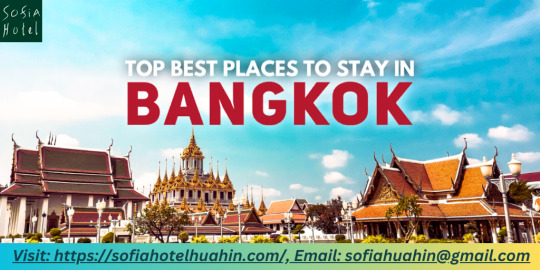
Fantastic river views, lofty ceilings with lots of natural teak, Thai silks, big French windows, roomy living spaces, and opulent bathrooms are all features of the rooms. offers a popular tea room in a vintage author's lounge. The only Rhassoul bath in the city is available at this award-winning spa, along with unique spa fare. By boat, it takes 10 minutes to get to the BTS Saphan Taksin/central Sathorn dock. Asiatique, River City Shopping Centre, Grand Palace, the Flower Market, Wat Pho, and Wat Arun are a few of the nearby riverside attractions.
2. Anantara Riverside Bangkok Resort
Elegant riverfront hotel with a resort-style design that is decorated with Thai influences. Seven different room types, ranging from comfortable deluxe rooms (38 square meters) to large two-bedroom river suites (114 square meters), all come with free cellphones with free calls to ten different countries. Highlights include a personal chef's dramatic Teppanyaki dinner show, nightly Thai cultural performances with eating by the river, dinner and overnight cruises in the hotel's own renovated rice barges, and the possibility to rent Thai-style wooden structures for proposals and special celebrations. Asiatique, a well-known nightlife district, and night market, is located directly across the river. The hotel is located 15 minutes by boat from Central Pier (the BTS entrance to downtown Bangkok).
3. Anantara Siam
Elegant luxury hotel with a traditional fusion of Thai and modern styles. has a Jim Thompson Explorer Suite and 354 exquisitely designed rooms ranging in size from 42 to 126 square meters. Free smartphones with a digital city guide and free calls to ten countries are available in every room. There are several stores, restaurants, squash courts, koi ponds, indoor garden courtyards, and other attractions to visit. Excellent outdoor pool. Beautiful spa with relaxing Roman-style pools and adjustable hydraulic beds. The hotel gives visitors the opportunity to take part in a customary Buddhist rite of giving alms to monks. has a prime location in the heart of Bangkok's renowned shopping district, close to Central World, Pratunam Market, and Siam Paragon, among other retail centers and marketplaces.
4. Siam Kempinski
Exceptionally lavish, palatial hotel with a regal aura, situated in the center of Siam's shopping district, with easy access to BTS Siam via the Siam Paragon shopping center. The hotel has an image of opulent splendor thanks to its enormous teakwood doors that reach the ceiling, lit staircases, lamps designed to look like Thai dancers' nails, wide corridors, and gold and earth-toned decor. consists of 401 beautiful rooms and suites that are dispersed across many wings and centered around a central courtyard with a garden and a free-form swimming pool. The only hotel in Bangkok with special cabana rooms that let visitors jump into the pool from their own private patios.
It feels like a luxurious tropical retreat yet being close to the BTS. Restaurants have distinctive elements, such as an interior traditional Thai pavilion (sala). further gives visitors the choice of having a single dish prepared in various ways (Asian or non-Asian). Extremely handy position in the Ratchaprasong shopping area, next to the Pratunam market, Siam Paragon Mall, MBK Centre, Bangkok Art & Cultural Centre (BACC), Siam Discovery Mall, and Central World.

5. Banyan Tree
A contemporary hotel with 61 floors and stunning views of Bangkok is situated in the city's financial sector. has 325 wonderful rooms with modern and Thai touches that range in size from 44 to 143 square meters. Famous for its distinctive rooftop restaurant and bar that was formerly a helipad and provides an unmatched experience of dining beneath the stars. The hotel provides distinctive Spa Sanctuary Suite suites, which come with individual massage rooms and limitless massage treatments, in addition to its award-winning spa services. Additionally runs the excellent Apsara Cruise, a dinner cruise on an antique teak rice barge with private cooks and individualized menus. A great place to explore the Silom neighborhood. close to Maggie Choos, Ce La Vie, and Lumpini Park.
The best hotels in Thailand, as determined by our experts, include five-star resorts, boutique hotels, affordable lodging options, and Bangkok hotel specials. Read the book and the reviews.
To reach us out in offline mode do not forget to visit
SofiaHotelHuahin
100 / 3 - 6 Poonsuk Road Hua Hin, Prachuap Khiri Khan, Thailand 77110
Email: [email protected]
Visit Our website — https://sofiahotelhuahin.com/
0 notes
Text
Monasteries, Mountains & More: On A Manali To Ladakh Bike Trip
A bike trip from Manali to Leh Ladakh is not only an adventure in terms of the scenic landscapes and challenging terrain, but it also offers a unique opportunity to immerse oneself in the rich cultural and spiritual aspects of the region. Let's explore some of the cultural and spiritual experiences you may encounter on this journey:
High-altitude Lakes: The journey from Manali to Ladakh takes you through breathtaking landscapes and pristine high-altitude lakes, such as Pangong Tso and Tso Moriri. These serene locations are considered spiritually significant by the locals and are believed to possess healing properties.
Buddhist Monasteries: Ladakh is predominantly a Buddhist region, and you'll come across numerous monasteries or gompas along the way. These monasteries, such as Hemis, Thiksey, and Diskit, are not only architectural marvels but also serve as important centres for spiritual practices. You can witness monks engaged in prayer chants, visit meditation halls and even participate in religious ceremonies if you're respectful and seek permission.
Prayer Flags and Mani Walls: Throughout your journey, you'll notice colourful prayer flags fluttering in the wind and Mani walls adorned with engraved stones. These are integral aspects of Tibetan Buddhism. The prayer flags carry sacred mantras and prayers, believed to spread blessings and good fortune. As you ride past them, it is customary to keep them to your right side as a sign of respect.
Local Festivals: If you time your trip well, you might have the opportunity to witness local festivals celebrated with great fervour in Ladakh. The Hemis Festival, Losar (Tibetan New Year), and Dosmoche are some of the significant events. These festivals involve vibrant masked dances, traditional music, and performances that showcase the cultural heritage of the region.
Homestays and Local Hospitality: As you traverse on your Manali to Ladakh bike trip through remote villages and towns, consider staying in homestays to experience the warmth and hospitality of the locals. Interacting with Ladakhi families allows you to learn about their way of life, traditional customs, and cuisine. You can even participate in daily activities like cooking, farming, or helping with household chores.
Tibetan Buddhism and Meditation: Ladakh has become a hub for spiritual seekers, with many individuals and groups flocking to the region for meditation retreats and spiritual practices. If you're interested, you can join meditation centres, attend teachings by experienced Buddhist teachers, or explore meditation caves known for their tranquil ambience and conducive environment for introspection.
Local Cuisine and Tea Houses: A Manali to Ladakh road trip is incomplete without food! Along the route, you'll encounter small tea houses or roadside eateries where you can savour the local cuisine. Traditional dishes like Thukpa (noodle soup), Momos (dumplings), and Butter Tea are popular and provide a taste of the local flavours. Sharing meals with fellow travellers or locals can lead to interesting conversations and cultural exchange.
Ancient Temples and Rock Art: Apart from Buddhist monasteries, Ladakh is also home to ancient Hindu temples and rock art sites. The Alchi Monastery, Basgo Monastery, and Lamayuru Monastery incorporate elements of Hindu and Buddhist architecture. The region also boasts prehistoric rock art, showcasing the ancient cultural heritage of the area. Manali is home to several ancient temples that hold immense cultural and spiritual significance. The Hadimba Temple, dedicated to the goddess Hadimba, and the Manu Temple, dedicated to the sage Manu, are popular pilgrimage sites visited by locals and tourists alike.
Traditional Folk Music and Dance: The cultural heritage of Manali is celebrated through vibrant folk dances and music. During festivals and special occasions, you may witness locals performing traditional dances like Nati and Kayang. Ladakh has a vibrant folk music and dance tradition. You may have the opportunity to witness performances of traditional Ladakhi music and dance forms like the "Daman" dance or "Zhungdra" songs. These cultural expressions reflect the joys, struggles, and celebrations of the local communities.
Self-Reflection and Inner Peace: The challenging terrains and isolation of the journey provide an opportunity for self-reflection and introspection. Many travellers find solace and a sense of spirituality in the solitude and vastness of the Himalayan landscape, fostering inner peace and personal growth.
Manali to Leh Ladakh distance by bike measures to be about 430 kilometres. This journey not only promises thrilling adventures through breathtaking landscapes but also opens the door to a world of cultural and spiritual exploration. From the tranquil Buddhist monasteries and colourful prayer flags to the warmth of local hospitality and mouth watering cuisine, every step of the journey is an opportunity to connect with the rich traditions and spiritual heritage of the region. By immersing yourself in these cultural experiences, you'll not only create lasting memories but also gain a profound appreciation for the vibrant tapestry of Ladakh's cultural and spiritual aspects. So gear up, embrace the journey, and get ready for an unforgettable adventure filled with awe-inspiring sights and enriching encounters.
If you want to read more information about Bike Trip, just visit : https://www.universaladventures.in/state/Ladakh”
#manali to leh ladakh#Manali to Ladakh bike trip#manali to ladakh road trip#manali to leh ladakh distance by bike
0 notes
Text
Hillwalking & meditation
Hillwalking & meditation retreat.
Despite the train strike, I managed to get up to Stirling, without any drama. I got into a shared mini-bus up to Dhanakosa the Buddhist Retreat Centre. It had been a long time since I visited; (10 years) last time was a yoga retreat. I thought I would try the Hill Walking & Meditation course.
We did 3 days of hillwalking and a lot of meditation
it is an…

View On WordPress
#Buddhism#Hill Walking#loch voil#mediation#Munroes#NEWCASTLE#North Shields#scotland#Stirling#Walking#walking UK#Whitley Bay
0 notes
Photo

We are delighted to announce that the ordinations of the following three men took place at Sudarshanaloka Retreat Centre in New Zealand on 23rd March 2023: Roberto Gonzalez-Casanovas becomes Buddhanusarin (both ‘a’s are long), a Sanskrit name meaning “He who is a follower of the Buddha” Private preceptor Ratnavyuha Fraser Bruce becomes Darsanasiddhi (acute accent over the first ’s’ ), a Sanskrit name meaning “He who has the accomplishment of vision” Private preceptor Guhyasiddhi Malcolm Dow becomes Sthiraratna (long ‘i’), a Sanskrit name meaning “He whose jewel-like quality is firm and steadfast” Private preceptor Silaratna The Public preceptor for all three men was Purna. Sadhu! Sadhu! Sadhu! #Ordinations #Buddhist #Triratna #commitment https://www.instagram.com/p/CqN2ZNVs83_/?igshid=NGJjMDIxMWI=
0 notes